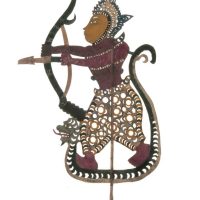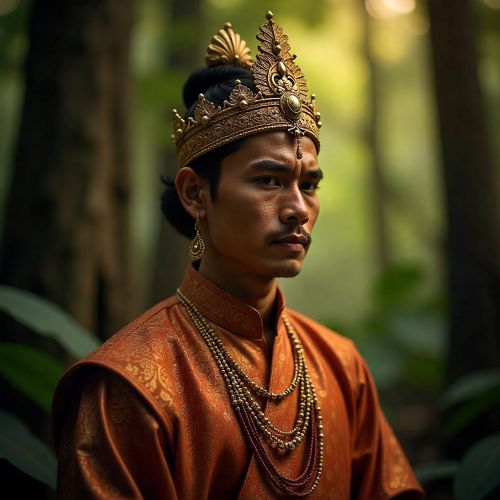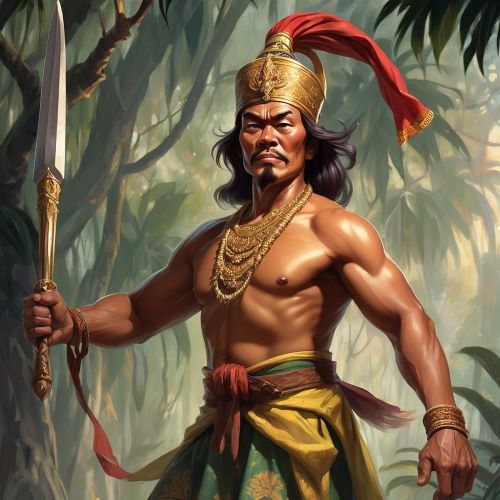Laksamana : The Legendary Malay Warrior of Hikayat Seri Rama
Listen
At a glance
| Description | |
|---|---|
| Origin | Malaysian Mythology |
| Classification | Mortals |
| Family Members | Seri Rama (Brother) |
| Region | Malaysia |
| Associated With | Loyalty, Warrior |
Laksamana
Introduction
In the Malaysian adaptation of the Ramayana, known as Hikayat Seri Rama, Laksamana emerges as one of the most compelling and heroic figures in the entire narrative. While derived from Lakshmana of the original Indian epic, the Malay version reshapes him with distinctly regional, Islamicised, and cultural attributes that set him apart from his Sanskrit counterpart. Within Hikayat Seri Rama, Laksamana is portrayed as the embodiment of unwavering loyalty, moral purity, and exceptional courage. His presence often outshines even Seri Rama himself, as Malay storytellers elevate his devotion and martial skill to near-supernatural heights.
This adaptation recasts Laksamana not just as a younger brother but as a guardian whose strength, clarity, and decisiveness anchor the story. His actions deeply influence the narrative arc, making him central to the Malay understanding of righteousness, familial duty, and heroic virtue. Through centuries of oral performance, wayang kulit, and written manuscripts, Laksamana has become one of the most beloved characters in Southeast Asian storytelling, representing the ideal of a warrior who protects with both heart and discipline.
Physical Traits
The physical depiction of Laksamana in Hikayat Seri Rama reflects the Malay ideal of a noble hero. He is consistently illustrated as strong, youthful, and disciplined, radiating a calm confidence that sets him apart from other characters. Traditional wayang kulit puppets show him with refined features, long limbs, and a poised stance, symbolising grace and spiritual purity. These visual conventions emphasise his role as a balanced warrior—one who fights fiercely but remains anchored in duty and wisdom.
His attire often includes flowing garments decorated with intricate Malay motifs, along with the accessories typical of heroic figures in local epics. While his Indian counterpart is usually associated with a bow, the Malay version more often features weapons that reflect Southeast Asian aesthetics, such as the keris or other traditional blades, underscoring his alignment with local culture. His physical presence in Hikayat Seri Rama is always one of readiness, reflecting his constant vigilance and devotion to protecting Seri Rama and Sita.
Family
In Hikayat Seri Rama, Laksamana is the younger brother of Seri Rama, and their relationship lies at the emotional core of the epic. The Malay version expands the emotional nuances of this bond, presenting Laksamana as a figure who not only supports his brother but serves as his moral compass. His devotion to Seri Rama is unwavering, often depicted as surpassing even Rama’s own resolve.
His relationship with Sita (Siti Dewi in the Malay version) also takes on unique characteristics. While he remains dutiful and respectful, he is often portrayed as fiercely protective, ensuring her safety during the couple’s exile in the forest. The Malaysian tradition sometimes introduces narrative elements that deepen this dynamic, highlighting Laksamana as an essential guardian figure.
One of the most distinctive features of Hikayat Seri Rama is the portrayal of Hanuman as the son of Seri Rama rather than a separate figure of divine origin. This creates a different family structure, where Laksamana interacts with Hanuman more like an uncle and protector. These relationships collectively reinforce Laksamana’s role as a steadying force in the family, affirming the Malay theme of kinship as sacred duty.
Other names
Although derived from the Sanskrit name Lakshmana, the Malay tradition simplifies it to Laksamana, a form that reflects the linguistic and cultural context of the archipelago. Unlike the Indian narrative where the name strictly refers to a person, Malay storytellers often treat “Laksamana” like a role or honorific that signifies noble service and unwavering responsibility.
In regional variations of the Hikayat, he may also be referred to with respectful Malay titles that elevate his status within the narrative structure, but the name “Laksamana” remains the primary and culturally resonant form. This unique adaptation distinguishes him from the Indian character and gives him an identity deeply embedded in the heritage of the Malay-speaking world.
Powers and Abilities
Laksamana in Hikayat Seri Rama possesses exceptional abilities that blend human skill with elements of the supernatural, common in classical Malay literature. His combat prowess is unmatched; he is portrayed as a master of both armed and unarmed combat, capable of defending Seri Rama against powerful foes and magical beings. His sharp intellect and tactical acumen allow him to respond quickly in moments of crisis, often becoming the decisive factor in battles.
The Malay version of the Ramayana grants Laksamana abilities not found in the Indian epic. One notable example is a scene unique to Hikayat Seri Rama in which Laksamana commands Rama and Hanuman—who have been transformed into monkeys—to return to their human forms. This moment, absent from the original Sanskrit text, highlights Laksamana’s elevated status and spiritual authority in the Malay tradition.
His greatest strength, however, remains his loyalty. In Malay storytelling, loyalty is almost a spiritual force, and Laksamana’s devotion is portrayed as a powerful virtue capable of overcoming enchantment, temptation, and despair. Through this loyalty, he becomes the heartbeat of the narrative, embodying the moral ideals cherished in Malay society.
Modern Day Influence
Laksamana from Hikayat Seri Rama continues to shape cultural identity and artistic expression in Malaysia today. In wayang kulit performances, he remains one of the most admired characters, often portrayed with elegance and dignity. School textbooks, cultural studies, and university literature courses reference him as a model of loyalty, discipline, and heroism, ensuring new generations remain aware of his importance.
The character appears in contemporary literature, children’s books, comic adaptations, and stage plays, each reinterpreting him for modern audiences while preserving his classical traits. His presence in cultural discourse reinforces the Malay interpretation of the Ramayana as a unique heritage, distinct from Indian versions yet deeply connected to shared epic traditions. Through storytelling and performance arts, Laksamana remains a vibrant figure whose story continues to inspire values of devotion and courage across Malaysia.
Related Images
Source
Andaya, B. W., & Andaya, L. Y. (2001). A history of Malaysia (2nd ed.). Palgrave.
Encyclopedia Britannica. (2025). Laksamana. https://en.wikipedia.org/wiki/Laksamana
Hikayat Seri Rama. (2006). Malay epic adaptation. Manuscript.
Noor, F. A. (2025, June 25). Malaysian Ramayana. EducationWorld. https://educationworld.in/malaysian-ramayana/
Pattanaik, D. (2023, July 21). Ravana in Malaysia and Indonesia. Devdutt.com. https://devdutt.com/ravana-in-malaysia-and-indonesia/
Ramayanas of Southeast Asia. (2018, March 5). University of Washington. https://jsis.washington.edu/csead/resources/educators/ramayanas-of-southeast-asia/
Yusof, N. (2023). Hang Tuah: The legend of the powerful Laksamana of Malaysia. Dipasanatani Blog. https://dipasanatani.com/2023/01/17/hang-tuah-the-legend-of-the-powerful-laksamana-of-malaysia/
The Different Versions of the Ramayana in South East Asia. (2016, June 25). The Better India. https://thebetterindia.com/58547/ramayana-story-different-asia-buddhist-jain-malaysia-thailand-burma/
Frequently Asked Questions
Who is Laksamana in Hikayat Seri Rama?
He is the loyal younger brother of Seri Rama and one of the central heroes of the Malay Ramayana tradition.
How is Laksamana different from Lakshmana in the Indian Ramayana?
The Malay version enhances his loyalty, gives him unique powers, and incorporates Islamic and local cultural elements.
What role does Laksamana play in Sita’s protection?
He acts as her guardian during exile, ensuring her safety while supporting Seri Rama.
Does Laksamana have supernatural abilities in the Malay version?
Yes, Hikayat Seri Rama includes unique magical moments, such as his power to restore transformed characters to human form.
How is Laksamana portrayed in Malaysian culture today?
He remains a celebrated figure in wayang kulit, literature, education, and modern retellings of the Ramayana.










